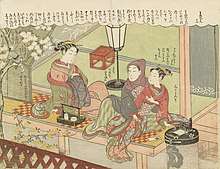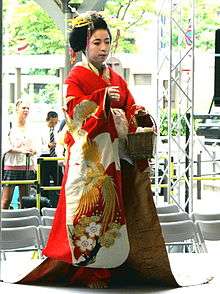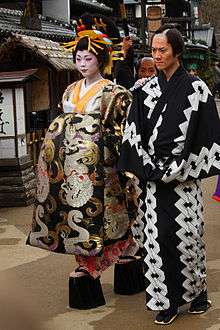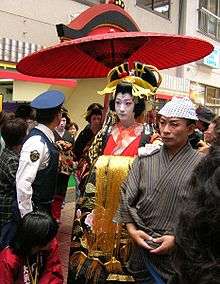Oiran
Oiran (花魁) were historically high-ranking courtesans in Japan.[1] Oiran were considered a type of yūjo (遊女) "woman of pleasure" or prostitute. However, they were distinguished from ordinary yūjo in that they were entertainers highly trained in the traditional arts, and had a greater degree of choice in who their customers would be.[2]


Many became celebrities both inside and outside the pleasure quarters, and oiran would often entertain the upper classes of society, gaining the nickname "keisei" (lit. "castle-toppler") for their perceived reputation of stealing the hearts of upper-class men. In kabuki, this archetype of oiran is commonly represented in both sewamono ("contemporary plays", in this case contemporary for the Edo period) and jidaimono ("period plays").
Though regarded as trend-setting, fashionable women at the height of the profession, this reputation was usurped in the late 18th and throughout the 19th century by geisha, who were seen as freer, more worldly, and easier to interact with.[3] The profession continued to decline steadily throughout the 19th century, before prostitution was outlawed in Japan in 1957.
Cultural aspects of oiran traditions, which differed in some cases significantly to geisha, continue to this day, preserved by re-enactors.[4][5]
Etymology
The word "oiran" comes from the Japanese phrase oira no tokoro no nēsan (おいらの所の姉さん) which translates loosely to "the lass at our (my) place." When written in kanji, the word consists of two characters, 花 meaning "flower", and 魁 meaning "leader" or "first." Technically, only the high-class prostitutes of Yoshiwara were called oiran, although the term is widely applied to all.[6]
History

Rise to prominence
Courtesan culture arose in the early Edo period (1600–1868); laws restricting brothels to bounded pleasure quarters (遊廓、遊郭 (yūkaku), in some cases quite literally walled-in districts, were passed in roughly 1600[3]:59.
These quarters were placed some distance from the city centre, and changed a number of times throughout the following centuries; on occasion, some would be closed and their inhabitants sent to live and work in another, larger district, or re-opened following a period of closure. The three districts with the most lasting prominence were Shimabara in Kyoto (which until the 1970s also housed geisha)[7], Shinmachi in Osaka, and Yoshiwara in Edo (present-day Tokyo).
These rapidly grew into large, self-contained neighborhoods, containing many different forms of entertainment, performances and festivals. Geisha also worked within these districts, occasionally being forbidden by law to work outside of them; as the geisha profession developed, rules regarding the separation of the two professions were passed.
Geisha were forbidden to dress elaborately, in the manner of oiran, and were not allowed to sleep with their customers. Geisha were registered at a separate registry office, and if an oiran accused a geisha of stealing a customer, she would be fully investigated, with the potential to be forbidden from working if found guilty.[3]:59
Status and rank
Compared to yūjo (prostitutes), whose primary attraction was sexual services, courtesans were first and foremost entertainers. In order to become an oiran, a woman had to be educated in a range of skills from a young age, including the traditional arts of chadō (Japanese tea ceremony), ikebana (flower arranging), and calligraphy. Oiran also learned to play the koto, shakuhachi, tsuzumi (hand drum), shamisen and kokyū.[8] Clients also expected them to be well-read and able to converse and write with wit and elegance.[9]
Within the pleasure quarters, courtesans' prestige was based on their beauty, character, education, and artistic ability, rather than their birth.[10]
The highest rank of courtesan was the tayū (太夫), followed by the kōshi (格子).[11][12] Unlike a common prostitute, the tayū had sufficient prestige to refuse clients.[13] Her high status also made a tayū extremely pricey—a tayū's fee for one evening was between one ryo and one ryo three bu, well beyond a laborer's monthly wage and comparable to a shop assistant's annual salary.[14]
In 1761, the last tayū of the Yoshiwara retired, marking the end of the tayū and kōshi ranks in that pleasure quarter. The word "oiran" therefore appeared in the Yoshiwara as a polite term of address for any remaining woman of courtesan rank.[15]
Appearance
Over time, oiran grew more and more elaborate in appearance; by their height at the beginning of the Edo period, oiran wore upwards of eight large hairpins, made of tortoiseshell, silver and gemstones in an elaborate, heavily-waxed hairstyle known as date-hyōgo.
An oiran's outfit would consist of a number of layered silk kimono, made of heavily-decorated silk and belted with an obi tied at the front. During the Edo period, this obi became wider in size and stiffer in material than in previous years, adding weight and discomfort to the outfit. This was worn underneath an even heavier uchikake, a formal overkimono, heavily embellished and padded, worn unbelted by the obi.
When outside, oiran wore koma geta - three-pronged, 20cm tall pauwlonia wood clogs. These would be relatively lightweight for their size, but would prevent an oiran from taking normal footsteps, meaning they would have to walk with a sliding, figure-of-8 (suri-ashi) step instead, and then with two manservants (wakaimono) to assist her. Oiran generally did not wear tabi socks, as the bare foot was considered to be a point of eroticism in the outfit. An oiran's clothing in total could weigh as much as 30kg,[note 1] and would require great assistance to put on.
Decline
Because oiran were isolated within the pleasure districts[3]:59 and bound by strict rules of etiquette and behaviour, the profession became steadily more traditional, ritualised and removed from popular society. This, alongside the high cost of courting oiran and the inaccessibility they posed, led to the profession's decline between the 18th and 19th centuries, eventually resulting in its complete fall from favour and outlaw in 1957.
Oiran represented an outmoded form of entertainment. The way an oiran spoke reflected formal court standards of a previous era, which generally did not change to reflect common language over time. Casual visitors of oiran would be rejected outright, and it would take three visits before an oiran would even consider sleeping with a customer - each time with great cost to the customer, and only then, if the oiran herself agreed.[2]:18
The appearance of oiran had always been exaggerated, but, over time, had become increasingly more ornate; in part, this prevented them from actually running away, as they would be unable to leave conspicuously once dressed, and unable to walk fast in koma geta.[2] However, this also represented a move towards preserving tradition and the high status of both oiran and their upper class customers - a general trend throughout the Edo period that reflected and kicked back against the rise of richer mechant classes.
Similarly, the entertainment that oiran offered had mostly remained unchanged since generations of courtesans previous. Though oiran played the shamisen, they did not play the popular and contemporary tunes composed for it, and instead stuck to longer ballads such as nagauta, which had refined, but restrained, lyrical content.[3]:59,259
Competition with geisha
In contrast, the geisha profession grew stronger over the years that oiran declined, and contributed in part, if not mostly, to this decline.
Though both geisha and oiran were likely to be indentured in some way to their "houses", geisha were not the same kind of physical property that oiran were considered to be to their employers and brothels. Geisha were allowed to leave the pleasure quarters whenever they wanted, and even though many went into debt or held some debt with their okiya, were seldom in the same financial situation an oiran could find herself in.[3]:68
Geisha were considered, officially-speaking, to be a relatively low-class form of entertainment; however, during the Edo period, they reflected the new desires and financial freedom of the merchant classes, who were also, technically speaking, lower class. As the merchant classes throughout Edo period society grew in wealth and profligacy, they became the main source of income for geisha, who were accessible in a way oiran could not be due to class structures at the time.
Geisha were cheap to patronise, informal to converse with, required few introductions before they would entertain a customer, and, over time, took the oiran's place as the pinnacle of fashion. Through various dress edicts aimed at controlling the working classes and preserving the upper class, extravagant or obvious displays of wealth had been outlawed and driven underground, bringing aesthetical senses such as iki into popularity. This was championed by geisha, who by law had been prevented from wearing such extravagant clothing.
Shamisen tunes such as kouta (lit. "short songs") became fashionable during the time period that geisha grew in popularity - a genre of songs that could be composed as fleetingly as haiku poems, and contained lyrics heavy in risqué humour and heartfelt themes. The upper classes who patronised oiran were not supposed to listen to, or enjoy, these songs, which heightened the appeal of the geisha as at the cutting edge of popular society at the time.
Later years (1850-1957)
Towards the end of the Edo period, the oiran continued to dwindle in popularity as the geisha grew in numbers and appeal. By the beginning of the Meiji era, official attitudes towards legalised prostitution within Japan had changed owing to the country's increasing international presence. Towards the end of the 19th century, geisha had replaced oiran as the entertainer and companion of choice for the wealthiest in Japanese society, with the central appeal of oiran having grown increasingly remote from everyday life.
Oiran continued to see clients within the old pleasure quarters, but were no longer at the cutting edge of fashion, and during the years of World War II, when any show of luxury was heavily clamped down upon, the culture surrounding oiran suffered even further, being dealt the final blow in 1957 by the Prostitution Prevention Law - after a which a time, the profession of courtesan as it once was, sex services and all, had become illegal.
Modern oiran
Tayū continue to entertain as geisha do, but no longer provide sex. However, there are fewer than five tayū, in comparison to the three hundred geisha in Kyoto today. The last remaining tayū house is located in Shimabara, which lost its official status as a hanamachi in the late 20th century because of the tayūs' decline.[17] However, some still recognize Shimabara as a "flower town", since geisha and tayū still work there and the activity of the tayū is slowly growing. The few remaining women still currently practising the arts of the tayū (without the sexual aspect) do so as a preservation of cultural heritage rather than as a profession or lifestyle.[18]
Courtesan parade

The Bunsui Sakura Matsuri Oiran Dōchū is an annual event held every April in Bunsui, Niigata (now part of the city of Tsubame). The parade, which takes place under the Spring cherry blossoms, historically re-enacts the walk made by top courtesans around their district in honour of their guests. The modern parade features three oiran in full traditional attire with approximately 70 accompanying servants. The oiran, who are named Shinano, Sakura, and Bunsui, have a slow distinctive gait because they wear 15 cm (5.9 in) high wooden sandals. Due to the event's popularity in Japan, organizers are inundated with applications to be one of the three oiran or a servant. Dōchū is a shortened form of oiran-dochu, it is also known as the Dream Parade of Echigo (Echigo no yume-dochu).

The Ōsu Street Performers' Festival is an event held around Ōsu Kannon Temple in Nagoya yearly around the beginning of October. The highlight of this two-day festival is the slow procession of oiran through the Ōsu Kannon shopping arcade. Thousands of spectators crowd the shopping streets on these days to get close enough to photograph the oiran and their retinue of male bodyguards and entourage of apprentices (young women in distinctive red kimono, white face paint and loose, long black hair reminiscent of Shinto priestesses).
An Oiran Dōchū parade is held in the Minamishinagawa district near Aomono-Yokochō, Shinagawa every September.[19]
See also
Notes
- This reference shows the Shochiku Costume Company and a modern reproduction costume of theirs for the role of Agemaki, a courtesan in the play Sukeroku. Though kabuki costumes are exagerrated, the costumes used for courtesans are highly similar to those used by oiran at the time (Edo period), making the techniques, decoration and fabrics used highly similar, if not entirely, and reliable as a resource for what oiran actually wore.[16]
References
- "Oiran". The Kyoto Project. Retrieved 30 March 2018.
- Kimino, Rinko; Ichikawa, Somegoro (2016). Photographic Kabuki Kaleidoscope (1st ed.). Tokyo: Shogakukan. p. 18. ISBN 978-4-09-310843-0.
- Dalby, Liza (1983). Geisha (3rd ed.). London: Random House Vintage. p. 59. ISBN 0 09 928638 6.
- ShinoStore (2015-02-22), OIRAN 花魁 - Japanese Lamp (020L), retrieved 2018-08-13
- ktodoma (2016-11-20), Oiran 花魁 in New York, retrieved 2018-08-13
- 2006-1-27, 藤田 真一, 京都・角屋の文化 ―学問の手伝えること― Archived 2011-03-21 at the Wayback Machine, Kansai University. Quote: 「花魁は、江戸の吉原にしかいません。吉原にも当初は太夫がいたのですが、揚屋が消滅したのにともなって、太夫もいなくなりました。その替わりに出てきたのが、花魁なのです。ですから、花魁は江戸吉原専用の語なのです。」
- Dalby, Liza. "The notes, references, and links listed here are keyed to the new preface "Geisha in the 21st Century" in the 25th anniversary edition of GEISHA". Liza Dalby. lizadalby.com. Retrieved 9 January 2020.
Note 12
- Seigle 1993, pp. 123, 202.
- Hickey 1998, p. 28.
- Hickey 1998, pp. 26-27.
- Early Modern Japanese Literature: An Anthology, 1600-1900. Columbia University Press, 2008.
- The life of an amorous woman. Taylor & Francis. Commentary "APPENDIX III. THE HIERARCHY OF COURTESANS" p. 286.
- Seigle 1993, p. 87.
- Ryū 2008, p. 69.
- Swinton 1995, p. 37.
- "Kabuki KOOL" (Youtube video). youtube.com. NHK World. Retrieved 9 January 2020.
(25:33)
- Dalby, Liza. "Courtesans and Geisha – the Tayû". www.lizadalby.com Retrieved 3-11-2014.
- Dalby 1995, p. 64.
- Miura, Yoshiaki (30 November 2014). "Shinagawa, a gateway to old and new Tokyo". The Japan Times Online. Retrieved 23 September 2018.
Further reading
- Swinton, Elizabeth de Sabato; Campbell, Kazue Edamatsu; Dalby, Liza Crihfield; Oshima, Mark (1995). The women of the pleasure quarter: Japanese paintings and prints of the floating world. Hudson Hills Press. ISBN 9781555951153.
- Dalby, Liza Crihfield. Chapter: Courtesan and Geisha: The Real Women of the Pleasure Quarter.
- Swinton, Elizabeth de Sabato. Chapter: Reflections on the Floating World.
- Becker, J. E. de (2000). The Nightless City: Or, The History of the Yoshiwara Yūkwaku. ICG Muse. ISBN 9784925080316.
- Hickey, Gary (1998). Beauty & Desire in Edo Period Japan. National Gallery of Australia. ISBN 9780642130846.CS1 maint: ref=harv (link)
- Longstreet, Stephen; Longstreet, Ethel (1988). Yoshiwara: The Pleasure Quarters of Old Tokyo. C.E. Tuttle Company. ISBN 9780804815994.
- Ryū, Keiichirō (2008). The Blade of the Courtesans. Vertical. ISBN 9781934287019.CS1 maint: ref=harv (link)
- Seigle, Cecilia Segawa (1993). Yoshiwara: The Glittering World of the Japanese Courtesan. University of Hawaii Press. ISBN 9780824814885.CS1 maint: ref=harv (link)
External links
| Look up 花魁 or oiran in Wiktionary, the free dictionary. |
| Wikimedia Commons has media related to Oiran. |